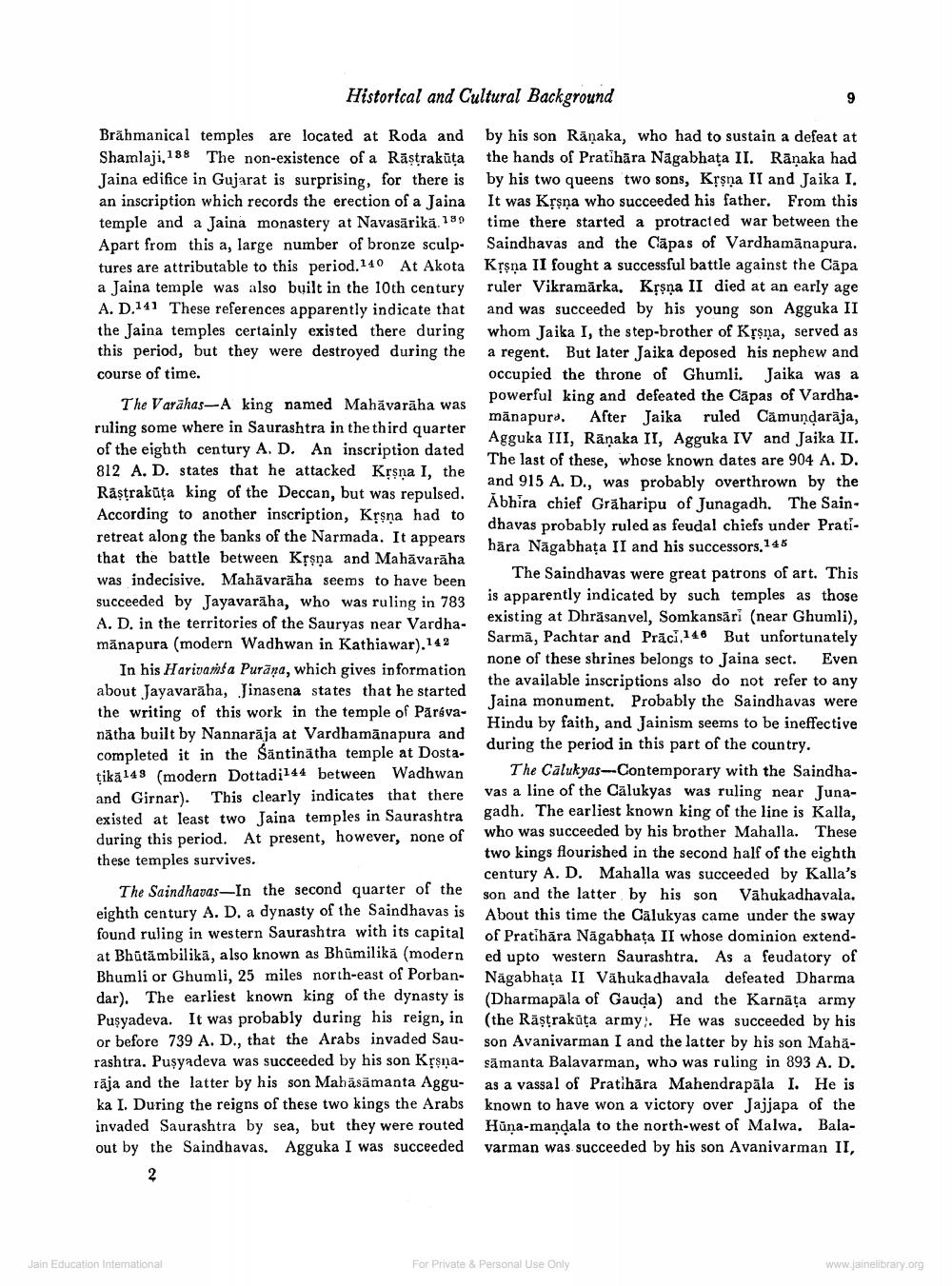________________
Historical and Cultural Background
Brāhmanical temples are located at Roda and by his son Rāņaka, who had to sustain a defeat at Shamlaji, 188 The non-existence of a Rāstrakūta the hands of Pratihāra Nāgabhata II. Rāņaka had Jaina edifice in Gujarat is surprising, for there is by his two queens two sons, Krsna II and Jaika I. an inscription which records the erection of a Jaina It was Kļşņa who succeeded his father. From this temple and a Jaina monastery at Navasārikā. 189 time there started a protracted war between the Apart from this a, large number of bronze sculp. Saindhavas and the Cāpas of Vardhamānapura. tures are attributable to this period.140 At Akota Krşņa II fought a successful battle against the Capa a Jaina temple was also built in the 10th century ruler Vikramārka. Krşņa II died at an early age A. D.141 These references apparently indicate that and was succeeded by his young son Agguka II the Jaina temples certainly existed there during whom Jaika I, the step-brother of Kțşņa, served as this period, but they were destroyed during the a regent. But later Jaika deposed his nephew and course of time.
occupied the throne of Ghumli. Jaika was a The Varāhas-A king named Mahāvarāha was
powerful king and defeated the Capas of Vardha.
mānapura. After Jaika ruled Camundarāja, ruling some where in Saurashtra in the third quarter
Agguka III, Rānaka II, Agguka IV and Jaika II. of the eighth century A. D. An inscription dated
The last of these, whose known dates are 904 A. D. 812 A. D. states that he attacked Krsna I, the
and 915 A. D., was probably overthrown by the Rästrakūta king of the Deccan, but was repulsed.
Abhira chief Grāharipu of Junagadh. The SainAccording to another inscription, Krsna had to retreat along the banks of the Narmada. It appears
dhavas probably ruled as feudal chiefs under Prati
bära Nāgabhata II and his successors. 145 that the battle between Krşņa and Mahāvarāha was indecisive. Mahāvarāha seems to have been
The Saindhavas were great patrons of art. This succeeded by Jayavarāha, who was ruling in 783
is apparently indicated by such temples as those A. D. in the territories of the Sauryas near Vardha
existing at Dhrasanvel, Somkansāri (near Ghumli), mānapura (modern Wadhwan in Kathiawar).142
Sarmā, Pachtar and Prāci. 146 But unfortunately
none of these shrines belongs to Jaina sect. Even In his Harivamó a Purāna, which gives information
the available inscriptions also do not refer to any about Jayavaräha, Jinasena states that he started
Jaina monument. Probably the Saindhavas were the writing of this work in the temple of Pärava
Hindu by faith, and Jainism seems to be ineffective nātha built by Nannarāja at Vardhamānapura and
during the period in this part of the country, completed it in the Sāntinātha temple at Dostatikā148 (modern Dottadi144 between Wadhwan The Calukyas---Contemporary with the Saindhaand Girnar). This clearly indicates that there vas a line of the Calukyas was ruling near Junaexisted at least two Jaina temples in Saurashtra
gadh. The earliest known king of the line is Kalla, during this period. At present, however, none of
who was succeeded by his brother Mahalla. These
two kings flourished in the second half of the eighth these temples survives.
century A. D. Mahalla was succeeded by Kalla's The Saindhavas—In the second quarter of the
son and the latter by his son Vahukadhavala. eighth century A. D. a dynasty of the Saindhavas is About this time the Calukyas came under the sway found ruling in western Saurashtra with its capital of Pratihāra Nagabhata II whose dominion extendat Bhūtā mbilika, also known as Bhumilikā (modern ed upto western Saurashtra. As a feudatory of Bhumli or Ghumli, 25 miles north-east of Porban- Nāgabhata II Vähukadhavala defeated Dharma dar). The earliest known king of the dynasty is (Dharmapala of Gauda) and the Karnāta army Pusyadeva. It was probably during his reign, in (the Rästrakūta army. He was succeeded by his or before 739 A. D., that the Arabs invaded Sau- son Avanivarman I and the latter by his son Maharashtra. Puşyadeva was succeeded by his son Krşņa- sāmanta Balavarman, who was ruling in 893 A. D. rāja and the latter by his son Mahāsāmanta Aggu- as a vassal of Pratihāra Mahendrapāla I. He is ka I. During the reigns of these two kings the Arabs known to have won a victory over Jajjapa of the invaded Saurashtra by sea, but they were routed Hūņa-mandala to the north-west of Malwa. Balaout by the Saindhavas. Agguka I was succeeded varman was succeeded by his son Avanivarman II,
Jain Education International
For Private & Personal use only
www.jainelibrary.org




